Installation via ZIP file
- Download the app ZIP file from the Shopware Store.
- Navigate to „Extensions“ > „My extensions“ in the Shopware admin interface.
- Download the app ZIP file by clicking on the „Upload extension“ button in the top right corner.
- Now a new app will appear in the list called „API Flow Trigger – Execute Flows via API easily“. Please click on „Install app“ here.
- Once the installation is complete, enable the app by activating the switch on the left side.

Installation via Composer
In the command line, navigate to the Shopware 6 root directory and run the following command:
composer require store.shopware.com/AppliApiFlowTriggerInstall and activate the app by running the following commands:
bin/console plugin:install AppliApiFlowTrigger --activate
bin/console cache:clearSetup API Trigger in Flow Builder
Navigate to the Flow Builder.
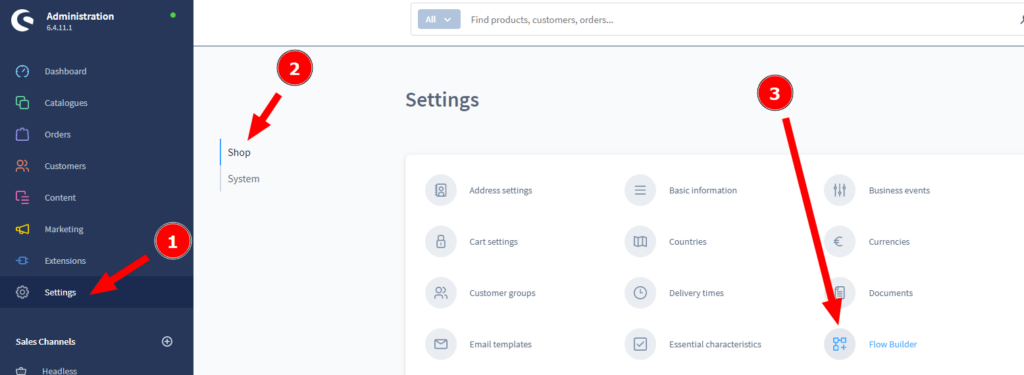
Add a new flow by clicking on the „Add flow“ button, insert a name, activate the flow and and switch to the „Flow“ tab.

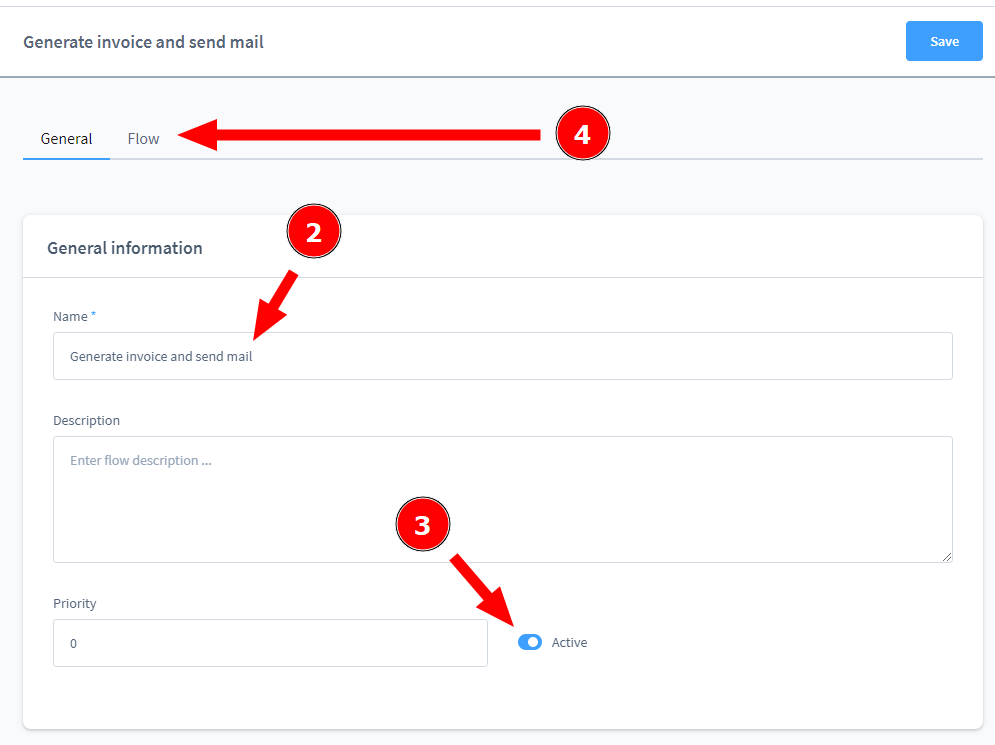
Now it’s time to choose the API Trigger, which dispatches the flow. Here you can decide between
„Customer“ and „Order“. In our example we choose „Order“, because we want to generate an invoice for a specific order and sent it to the customer via email.
Here is a explanation of both triggers:
- Order Trigger
Choose this trigger, if you want to do stuff, which is related to a specific order. This trigger enables you later to choose a specific order by providing a Order Number or Order ID when you send the API Request to your Shopware 6 instance. - Customer Trigger
Choose this trigger, if you want to do stuff, which is related to a specific customer. This trigger enables you later to choose a specific customer by providing a Customer Number, Customer E-Mail or Customer ID when you send the API request to your Shopware 6 instance.

Just add some actions and save the flow.
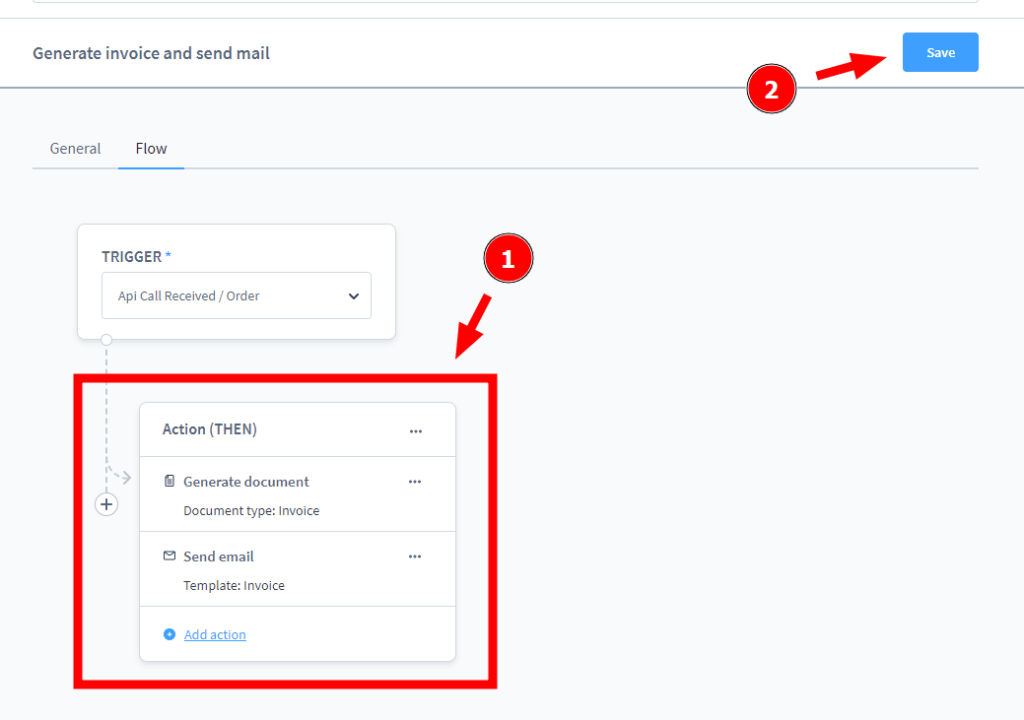
Authorize in Swagger UI
To trigger a flow for the first time, we use Shopwares inbuild Swagger UI. Swagger UI provides the technical API documentation and enables us to build and test our API request, which we can later use in production.
Navigate to your Swagger UI in a Shopware 6 Instance, should be in „dev“ mode. If you have no Dev-Environment by hand, you can test out the app’s functionality by using our Demo Shop. You can find the credentials here.
You can reach your own Swagger UI by navigating to: „http://insert-your-domain-here/api/_info/swagger.html„
At first we have to Authorize. Therefore we have to create a Integration first.
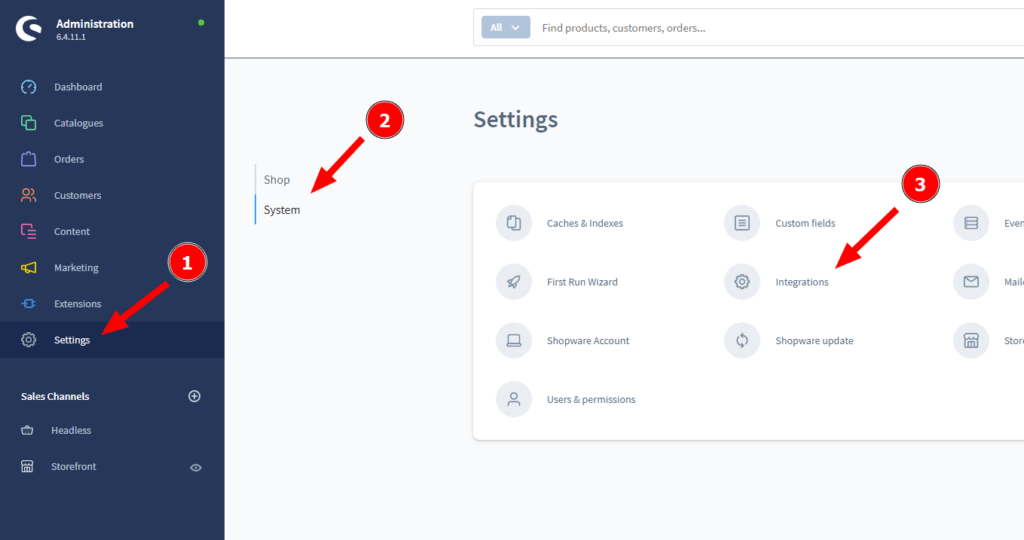
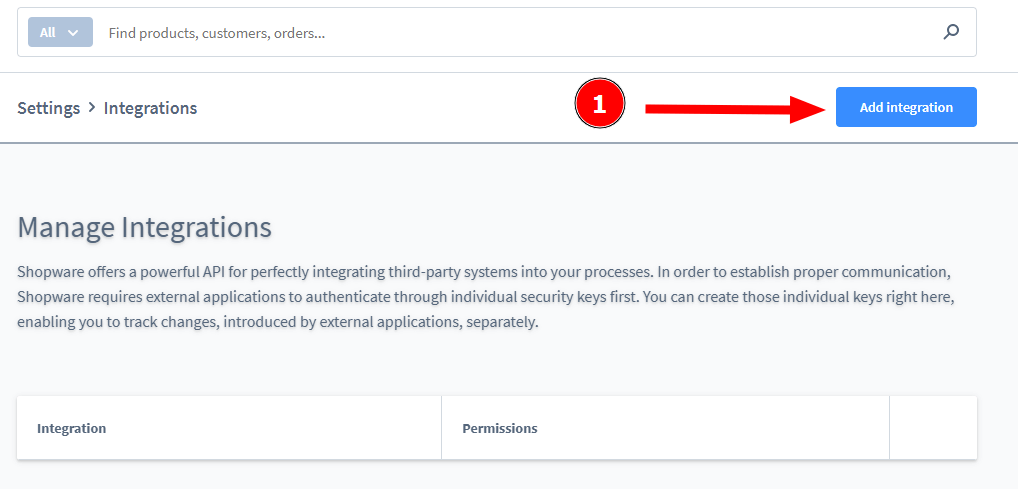
Back in our Swagger UI click on the „Authorize“ button on the right top corner.

Choose a proper name like „API Flow Trigger“ and choose the Role „Flow executor“.
Note down the Access Key ID and the Secret access key. We need it later and you won’t be able to see them again.
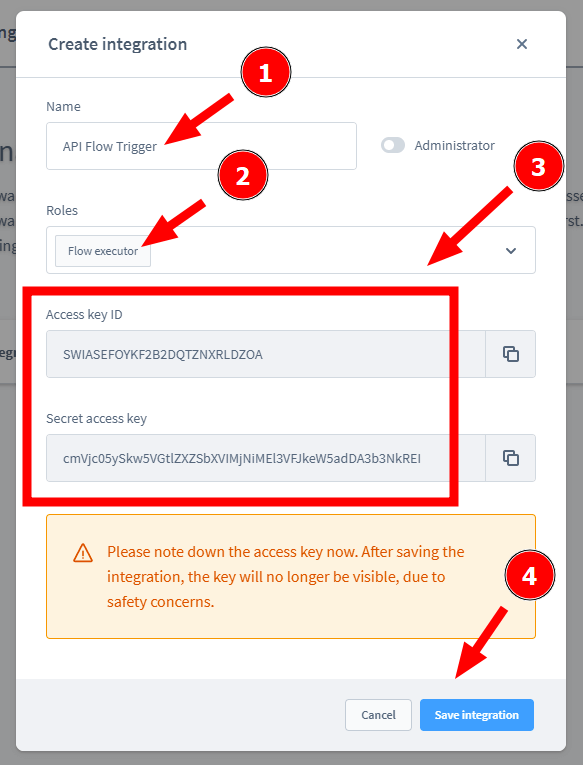
Now navigate to your Swagger UI (http://insert-your-domain-here/api/_info/swagger.html) or use the Demo Shop.
Click on the „Authorize“ Button in the top right corner.

When the dialog appears, scroll down and enter your Access Key ID in the field client_id. Enter your Secret access key in the client_secret field.
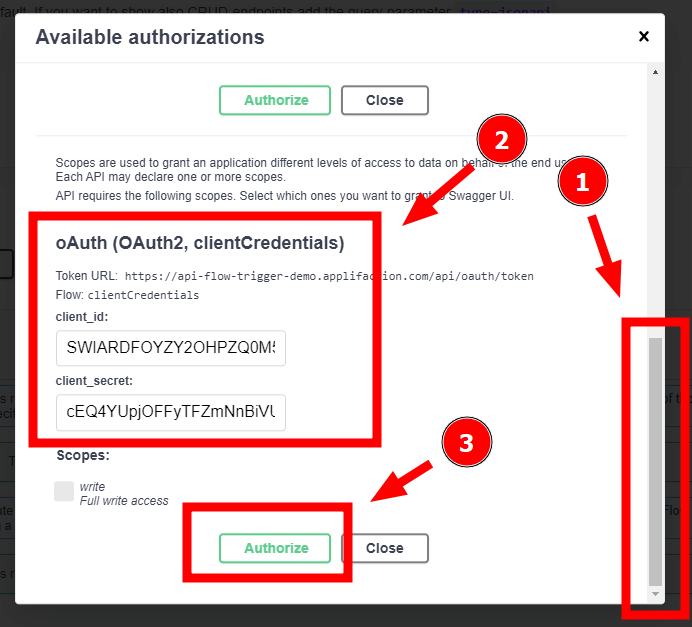
Excursion: Generate Bearer with CURL
When you want to authorize yourself later in production, you have to generate your Bearer Token programically.
Example CURL Command:
curl -X POST -H "Content-Type: application/json" \
-d "grant_type=client_credentials&client_id=<YOUR CLIENT ID>&client_secret=<YOUR CLIENT SECRET>" \
https://<YOUR SHOPWARE DOMAIN>/api/oauth/tokenYou will receive a Bearer Token in a response, which looks like this:
Example Response:
{"token_type":"Bearer","expires_in":600,"access_token":"eyJ0eXAiOiJKV1QiLCJhbGciOiJSUzI1NiJ9.eyJhdWQiOiJTV0lBUkRGT1laWTJPSFBaUTBNNUMwWExBRyIsImp0aSI6IjIxMDYwMjY2MDcyNmMzYmVlOGNhYzgzNmJkYjg1MTllODE4ZDY3NjdjYmU3Y2UzYzUzNDk3Yzg3ZWMzZjk1MTljODk3Y2ZhZjVlODVhZDgzIiwiaWF0IjoxNjU1MzA2Njk2LjkxODcyNywibmJmIjoxNjU1MzA2Njk2LjkxODcyOCwiZXhwIjoxNjU1MzA3Mjk2LjkxODQ0Nywic3ViIjoiIiwic2NvcGVzIjpbIndyaXRlIl19.g_kvJnwwfEvFg0SIqNcOkDxvdSHfojQT2NZ2gvXDx_xrAMwSyldt9Xbhi5JVIn5nRDu5Y1URoB77-Am0dn2RgqOpO3FUEiZF6E6HCnxueyQcIb-zc-iHFMIB63Ub16PL0ewwjFfk-Lfn2lXtUi4zdwgKKRPM-x_SAWcgeFzfFU3CN3VQWQrDZfNXrkic2BNjtIswprpPN812iv_J96EH3SrR83M3IdnDqSvrXRtZP7Uw1_ZdfcCtWHMcOIS7MQWaaHN4u2z-LqD981-EhOT6DZImz1oAJeISbdGmb1yi3ivAxwMCP4nQqpOBJLUDcQPHCE2zkhxgp1qMpfEhmt_piQ"}When you make your API requests, you have to add an „Authorization“ header with the value „Bearer (YOUR BEARER TOKEN)„
Example Request:
curl -X GET -H "Authorization: Bearer eyJ0eXAiOiJKV1QiLCJhbGciOiJSUzI1NiJ9.eyJhdWQiOiJTV0lBUkRGT1laWTJPSFBaUTBNNUMwWExBRyIsImp0aSI6IjViYzlmMWM5N2E1Y2FhOTkxNzdjNmQwMTcxNWMxNGIwMjA4ZjY4Mjg0ZTBkZjA0YjI4ZDE5YzEzZWFjYzRlZDdkNWUwOGM5MTQyNDU0YjllIiwiaWF0IjoxNjU1MzA2Nzk1LjQ2NTE2NCwibmJmIjoxNjU1MzA2Nzk1LjQ2NTE2NiwiZXhwIjoxNjU1MzA3Mzk1LjQ2NDY4Mywic3ViIjoiIiwic2NvcGVzIjpbIndyaXRlIl19.ksmUcBx_ExthlapTVTuHj6kAddNi8wfipVRPvey5e5w4OjW6SIwN8ynXObyvqqJZ4TIPKUFLGrc_47n5rWm-sRrBpBJvIt_mq6ICde0IGdctF3M2B8UAMsG4zDvhgdiudZ6BihxDmRoO1xjOwnMxTsj8NPiMSstzTRVY7EnsHOAo6oagBpi_LQaoKJ5o3mFY_asbu05potq_ng0ZO1gzBLXh3NE2RD5b9onGdOX6v_zrYZg_6zGDAmKZFS288oM13-5gs6am_-5RU5jqx_OtsNxxOyUYN_fEWCaNScmtEX5XpujSnDX3IpuJ8HkX9UKgCjeMvB3Ui7zAM7MGXLHC_g" \
https://<YOUR SHOPWARE DOMAIN>/api/flow-trigger/customer/flowsExcursion: Demo Shop
Swagger UI
Click on the „Authorize“ Button on the top right corner and enter following credentials in the oAuth (OAuth2, clientCredentials) section.
client_id:
SWIAZU5HEGJ3MVPJEEXYEUHEYWclient_secret:
MFlmbllGQWlKVVd4cmd5NGxpbWZsVFRhRzA5bVJ4MllqbzE3TWUList executable Flows via Admin API
At first we have to find out the Flow ID, of the flow we created earlier.
Because we used the „Order“ Trigger, we use the API route „/api/flow-trigger/order/flows“ to get a list of all triggerable flows.
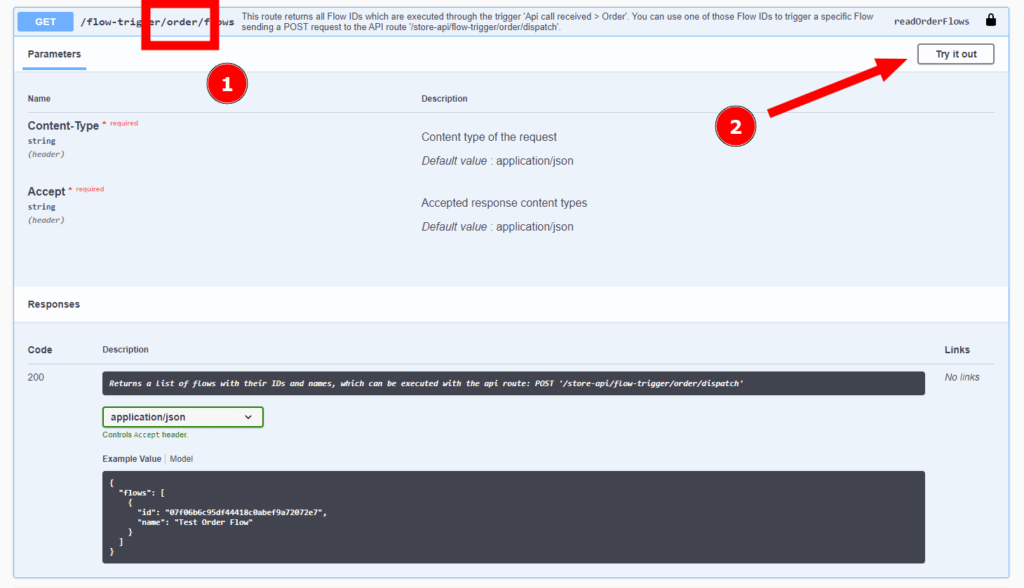
After you click on the „Execute“ button, you receive the ID and the Name of your previous created Flow. Please copy the ID in your clipboard.
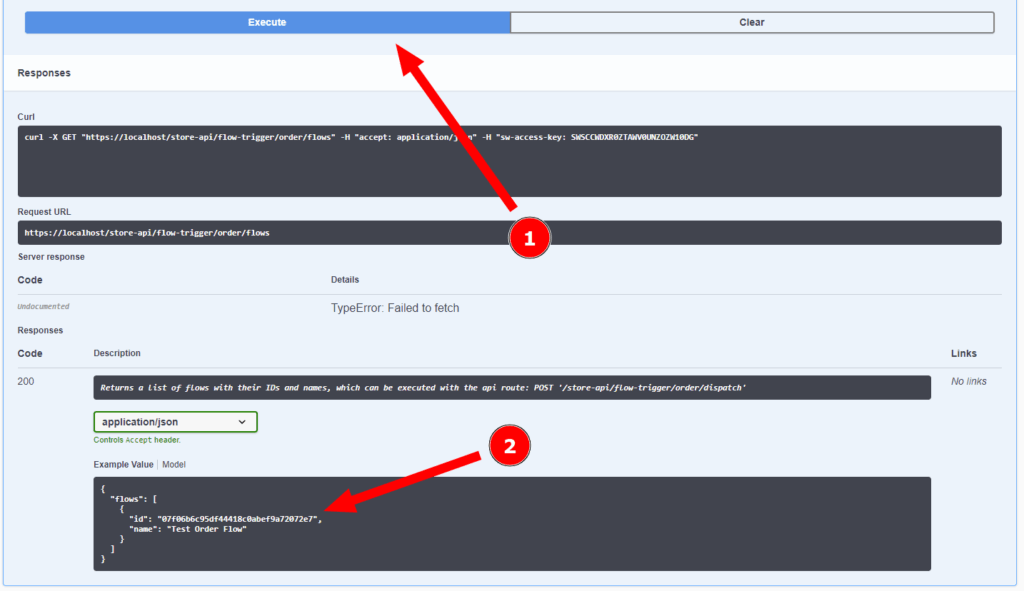
Excursion: List Flows with Customer API Triggers
If you used a „Customer“ Trigger in your Flow, you can use the „/api/flow-trigger/customer/flows“ API route to list executable Customer Flows.

Trigger Flows via Admin API
Click on the „Try it out“ button of the „/api/flow-trigger/order/dispatch“ API route.

Paste the Flow ID you copied earlier to the request body, remove the orderId parameter and enter a valid Order Number.
You can choose either to use the orderNumber or orderId parameter, when you create your own API requests later. But in this example, we use orderNumber.
After you entered your parameters, click on the „Execute“ Button.
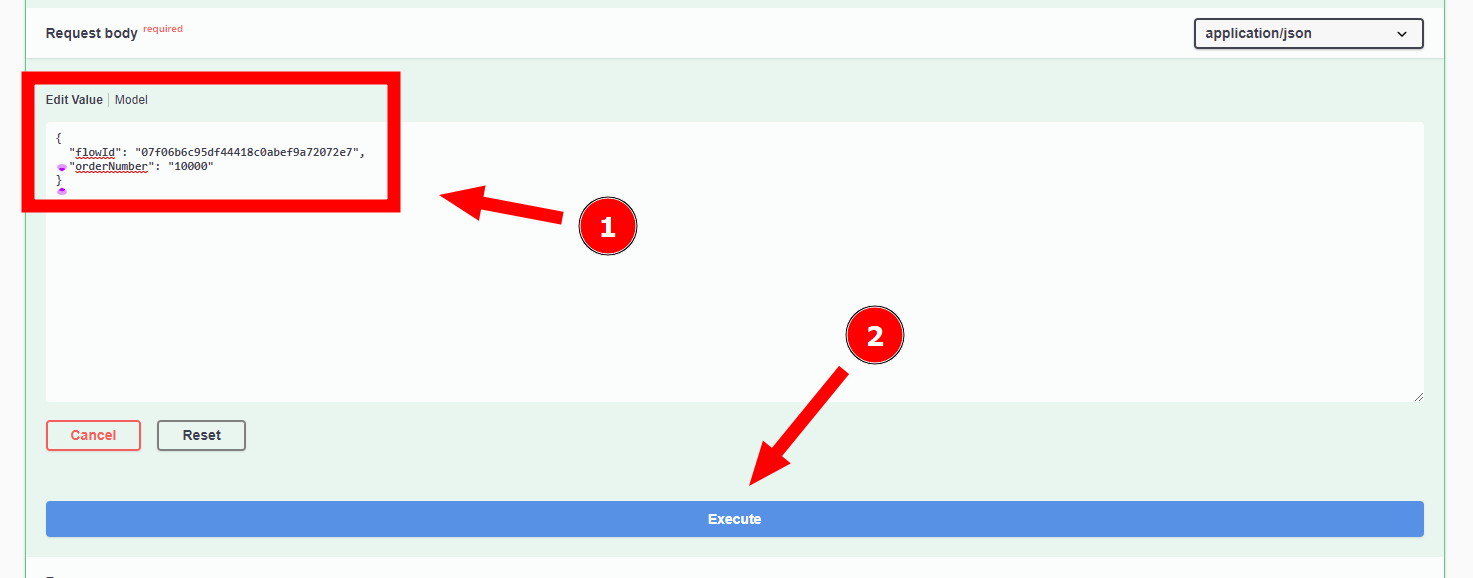
In depth explanation of request body parameters:
Click on „Model“ to get more information about the accepted parameters of the API route.

You can see the response body when you scroll down.
You can also see a Curl request, which you can use to send your own API request.
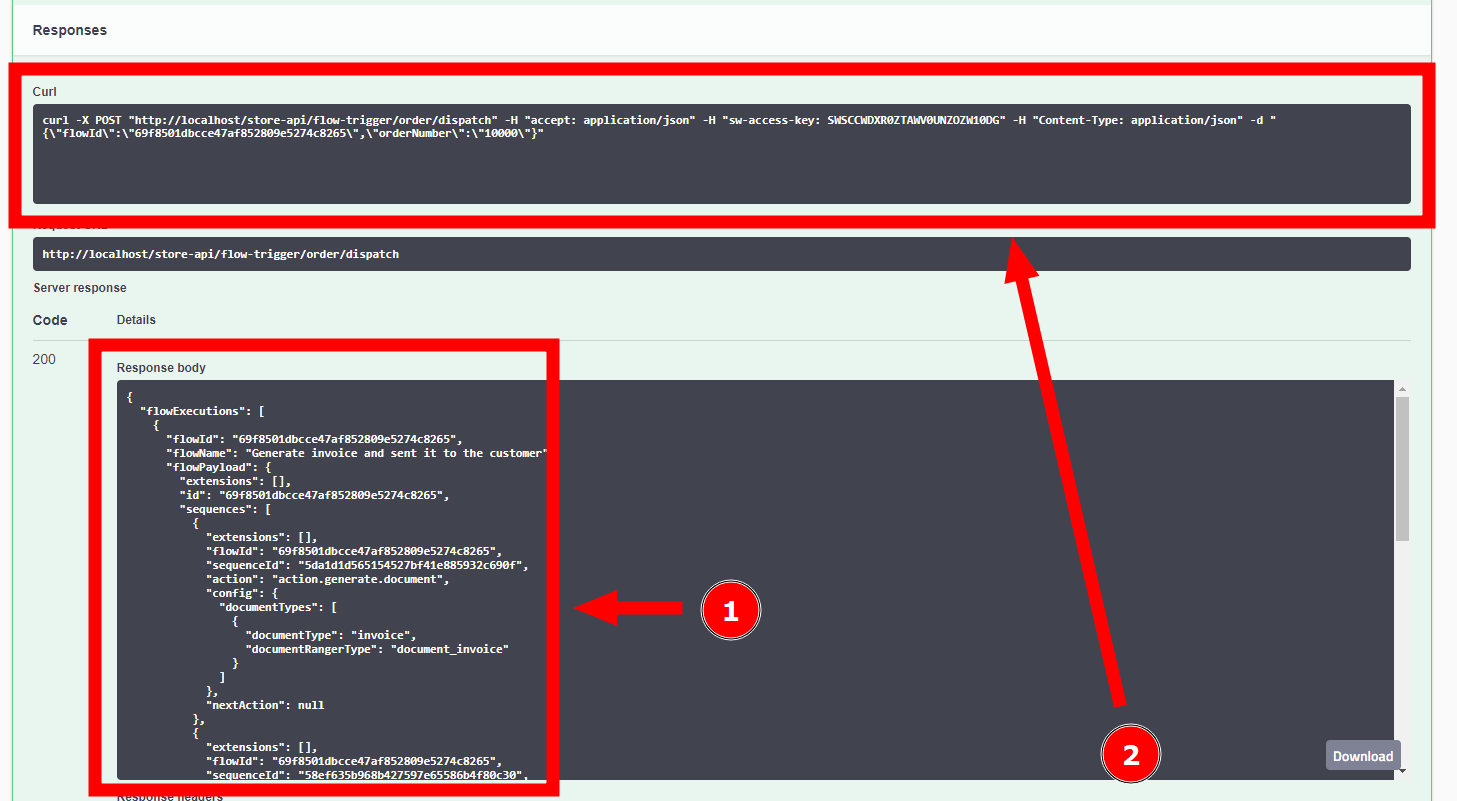
A in depth explanation of the response can be found, when you scroll down to the documentation of the responses and click on „Model„.
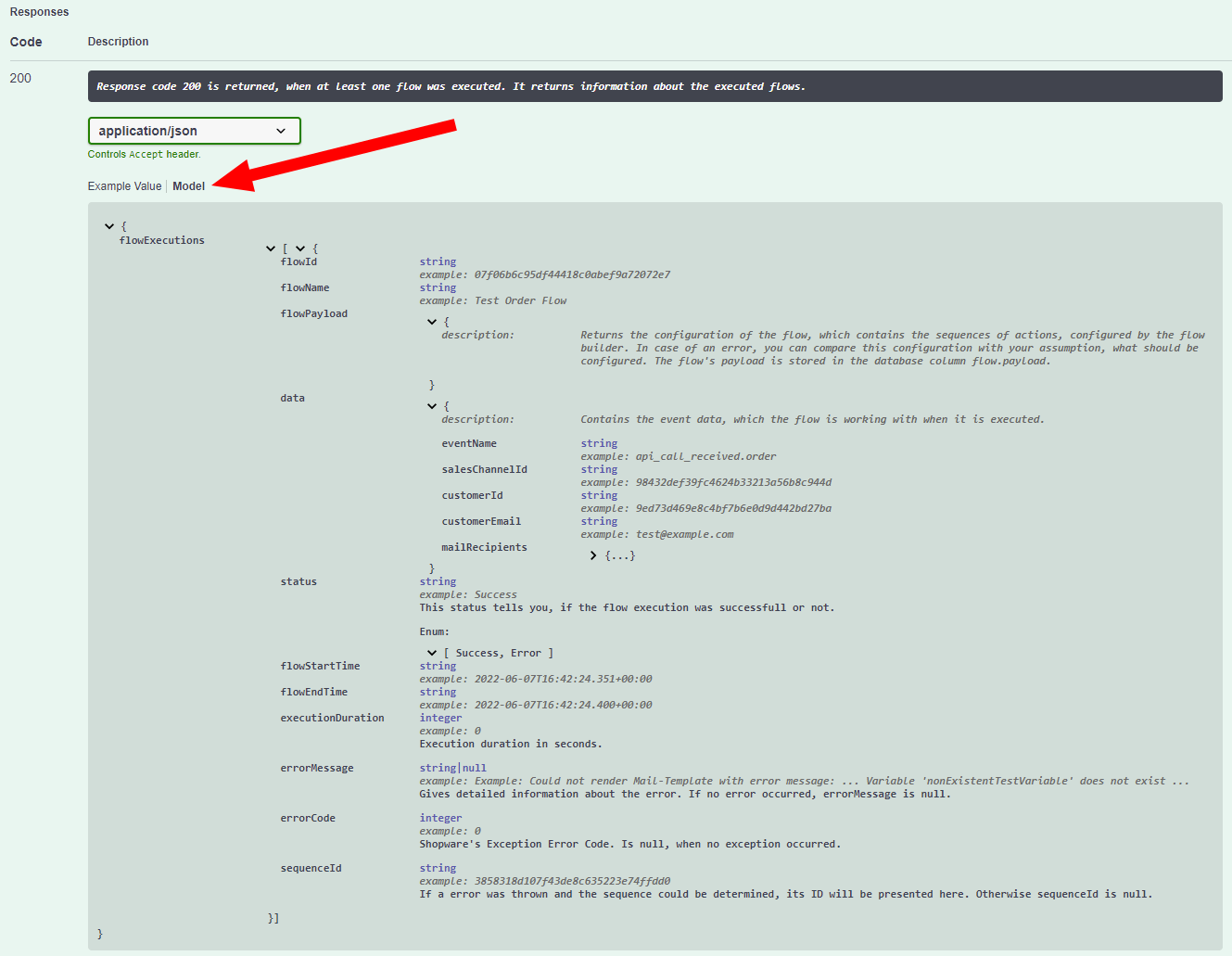
Excursion: Dispatch Customer Flows
Flows with the „Customer“ trigger are dispatched similarly.
The difference is, that you use the API route „/api/flow-trigger/customer/dispatch“.
Instead of the orderNumber or orderId request parameter, you have to use one of the parameters:
- customerId
- customerNumber
- customerEmail

Flow execution Log
In the Admin interface, you can find a detailed log, which shows all information about flow executions that are dispatched by the Admin API.
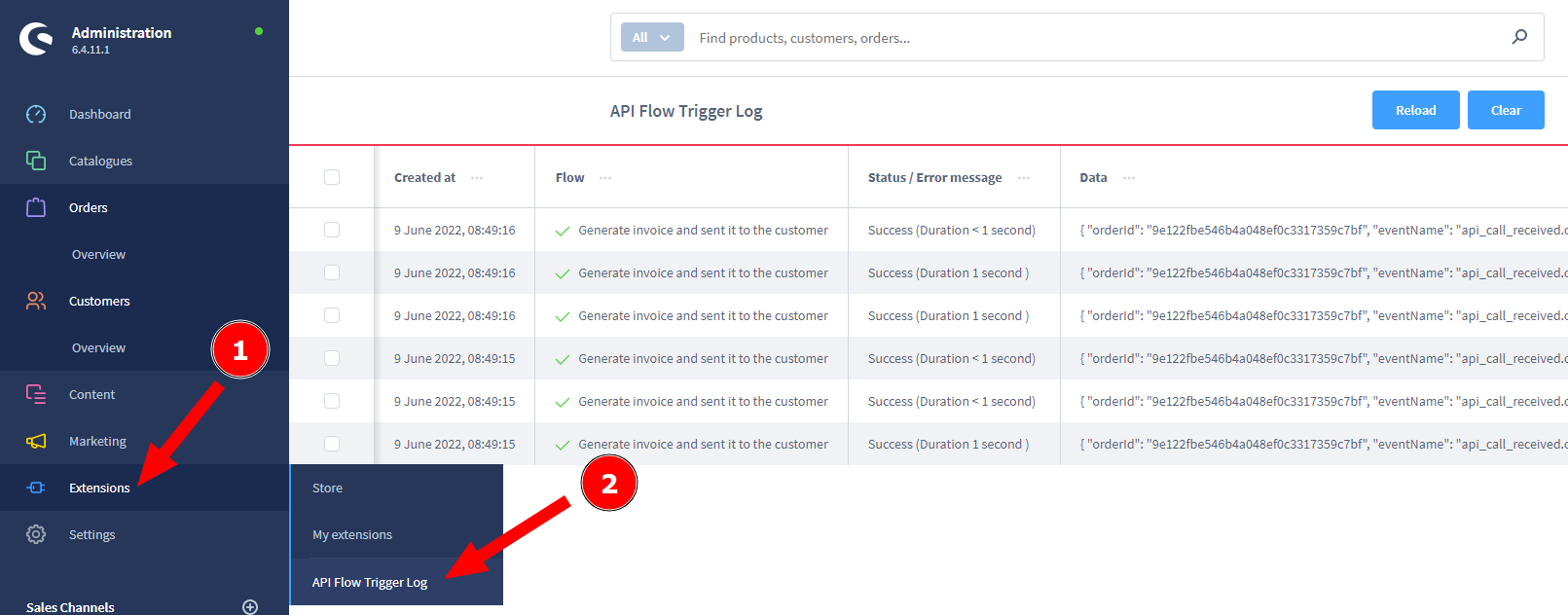
API Documentation
You can find the technical API documentation in the Swagger UI of the Demo Shop.
Click on on one of the following routes to get more infomration about it.

Click on the „Model“ link next to the Examples Values of Request bodies and Responses to get a detailed description about it.
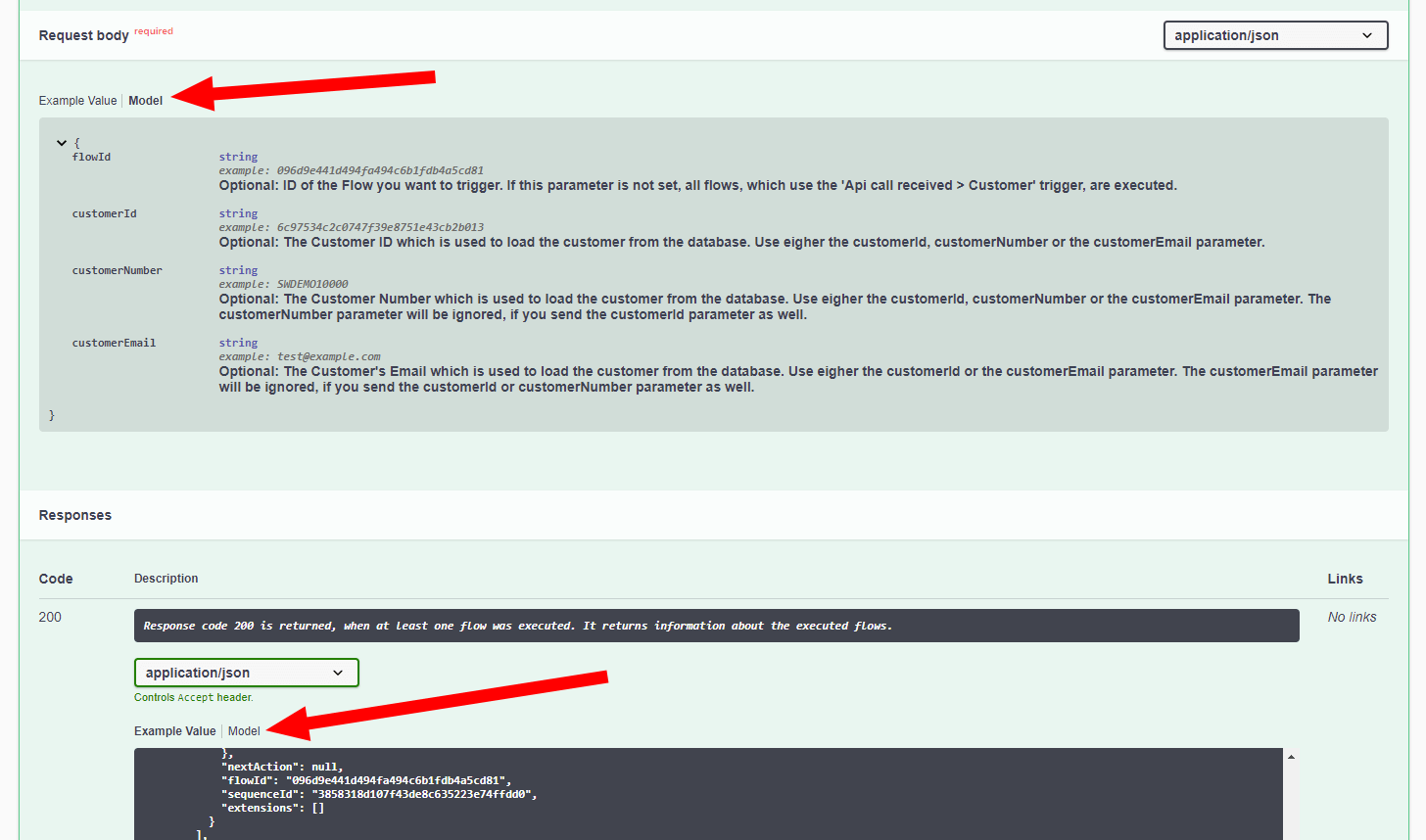
You can test the API in our demo shop. Just follow the instructions provided by this documentation. You should start by authorizing yourself in our Swagger UI.

